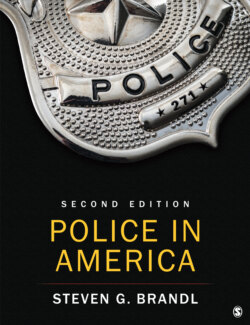Читать книгу Police in America - Steven G. Brandl - Страница 144
На сайте Литреса книга снята с продажи.
The Difficulties of Deterring Criminal Behavior
ОглавлениеAnother reason why crime control is difficult is that it is hard for the police to affect people’s behaviors. There are generally two approaches to controlling crime: incapacitation or deterrence. Incapacitation refers to making it impossible for people to commit crimes. For example, offenders who have been arrested and incarcerated are unable to commit additional crimes, at least outside of prison; they are incapacitated. In addition, if opportunities for criminal behavior are taken away, offenders may be incapacitated. For instance, if a would-be offender does not have a gun or access to a gun, that person is not going to be able to shoot someone, even if motivated to do so (although another weapon could be used). If a person is incapacitated in some way, he or she will not be able to commit a crime, or at least a specific type of crime. As such, the criminal behavior of that person will be controlled.
incapacitation: Making it impossible for people to commit crimes.
deterrence: Making someone decide not to do something.
While incapacitation as a way to control criminal behavior is relatively straightforward, crime control through deterrence is not. There are many important issues that need to be considered when thinking about the ability of the police to deter people from committing criminal behaviors. In order to deter behavior, to get someone to choose one behavior over another when both behaviors are an option, there have to be consequences for the undesired behavior. In the context of criminal behavior, the consequences usually come in the form of punishment. The first thing to note is the police usually do not control the punishment associated with a crime unless an arrest, a fine, or perhaps a use of force is considered the punishment. Moreover, in order for punishment to be an effective deterrent, it has to have at least three qualities. It has to be certain, meaning that the individual must believe that if the behavior is committed, punishment will follow. Punishment also has to be swift; it has to be administered quickly. Finally, punishment has to be individually meaningful. For example, a parking ticket of $50 might be individually meaningful to a person with a moderate income but not to a millionaire. Basically, in large measure the police are not able to control the certainty of punishment, the swiftness of punishment, or if the punishment is individually meaningful to the offender. The police are responsible for identifying and apprehending offenders but have relatively limited success in doing so (e.g., 46% of violent crimes and 17% of property crimes were solved in 2017). In this light, it is difficult to see how the police can deter people who are so inclined from committing crimes.
Further and even more fundamentally, another part of the difficulty in concluding whether or not—or to what degree—the police are able to deter people from committing crimes is defining exactly what is meant by deterrence and determining how it is measured. Is a man deterred from committing a bank robbery if he decides to commit it tomorrow instead of today? What if the would-be robber sees the police at a particular bank so he decides not to rob that bank but instead robs a different one down the block? Or decides to commit a bank robbery in a different city? What if instead of committing a robbery, he commits a burglary? Think about this issue in terms of the police trying to deter speeders. When you are driving down the street and see a patrol car, chances are you slow down. And then, just maybe, after you see that the officer is not behind you with lights and siren, you speed back up. Where you deterred from speeding? Deterrence is a slippery and difficult concept to define.
Exhibit 4.3 Tendencies Toward Criminal Behavior and the Impact of the Police
Group 1 consists of people who would obey the law even if there were no police.
Group 2 consists of people who obey the law because they fear the consequences of breaking it.
Group 3 consists of people who break the law even though they may get arrested by the police; they have no regard for the consequences. This group consists of criminals.
Some people do not need to be deterred; other people will not be deterred.
It is also important to recognize that not all people are equal in their criminal tendencies (see Exhibit 4.3). At some level of abstraction, there are probably people who would never commit a crime, or at least a serious crime. These people would obey the law even if there were no police, no threat of punishment (Group 1). On the other extreme are people who commit crimes with no regard for the police (Group 3). They are motivated to commit crimes regardless of the threat of police action. It is probably fair to say that no matter what the police do, these people will still commit crimes. The people in the middle are the people who would likely be affected by police actions and strategies to control crime (Group 2). Before committing a crime, they may consider the risks of getting caught by the police and punished by the criminal justice system. The point is that the police do not deter some people and do not need to deter others.
